 Toshiba Corporation, based in Japan, is a multinational engineering and electronics corporation. Toshiba develops a wide range of products and services such as information technology equipment, components and materials, power stations, lighting, consumer electronics, household appliances and more.
Toshiba Corporation, based in Japan, is a multinational engineering and electronics corporation. Toshiba develops a wide range of products and services such as information technology equipment, components and materials, power stations, lighting, consumer electronics, household appliances and more.
Toshiba used to develop OLED lighting panels, with plans to enter the market in 2015 - which never materialized. Toshiba, together with Sony and Hitachi, formed Japan Display in 2011. The company used to develop flexible OLED panels, but that seems to have been abandoned as well.
Today the company is producing OLED TVs (using WOLED panels produced by LGD).
1-1, Shibaura 1-chome
Minato-ku
Tokyo
105-8001
Japan
Toshiba to launch OLED TVs later this year
Toshiba announced that it will launch its first OLED TV later this year (probably in March). Toshiba will offer 55" and 65" 4K OLEDs in Japan for ¥700,000 (about $6,100) and ¥900,000 (about $7,900) - which is reportedly similar to LG's high-end OLED TVs in Japan.
Toshiba will use panels produced by LG Display - which is also supplying OLED TV panels to Japan-based Sony and Panasonic.
SEL unveils a 13.5" QFHD flexible OLED prototype
During the FPD International 2013, SEL unveiled a new 13.5" QFHD (3840x1260, 326 PPI) flexible OLED prototype. This is a WRGB panel (white OLEDs with color filters) and it uses a CAAS-OS (C-Axis Aligned Crystalline Oxide Semiconductor) substrate.

Toshiba was also showing a flexible panel - a 10.2" WUXGA (1920x1200, 223 PPI) WOLED panel on an IGZO backplane. This seems to be the same panel shown at SID 2013 in May 2013. Finally, Yamaga University's Research Center for Organic Electronics (ROEL) unveiled new flexible OLED technologies, including soluble organic-TFT based panels (on PET).
Toshiba's transmissive OLED lighting panels video
Update: the video has been removed from YouTube... sorry!
A couple of months ago Toshiba developed a unique transparent OLED lighting device structure that emits most of the light (over 95%) in only one direction. Toshiba showed these so-called "Transmissive OLEDs" SID 2013, detailing more technical information. Now we found this nice short video that shows the panels in action:
Toshiba, Panasonic and the FDC developed new flexible OLED panels
Several companies announced new flexible OLED panels at SID 2013. None of the panels were demonstrated (except for Toshiba which showed the OLED but it was not powered). First up is Toshiba, which showed a 10.2" 1920x1200 (223 PPI) panel. Toshiba's OLED has an Oxide TFT backplane and uses the WRGB (white OLED with color filters) architecture.
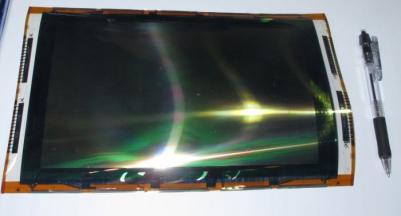 Toshiba flexible OLED prototype
Toshiba flexible OLED prototype
Panasonic developed a 4" flexible OLED with 224x224 resolution (only 80 PPI, direct emission). Panasonic used PEN as a substrate and the panel can be bent up to a curvature radius of 10 mm. This is also an Oxide-TFT panel. To produce it, Panasonic attached the PEN sheet to a glass substrate, deposited the OLED materials and then de-laminated the glass.
Toshiba shows their transmissive (one side transparent) OLED lighting panels
A couple of months ago Toshiba developed a unique transparent OLED lighting device structure that emits most of the light (over 95%) in only one direction. Now at SID 2013 the company unveiled more information about the new structure, calling these panels "Transmissive Single-sided OLEDs".
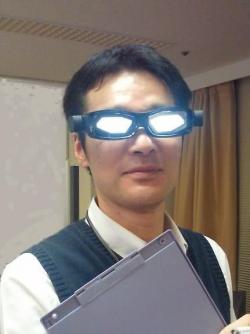
Regular transparent OLEDs use transparent electrodes (usually made from ITO) for both sides of the panel. When the OLED is turned on, it emits light in both directions. Sometimes this poses problems - if you want to embed such panels in windows, for example, you don't want light pollution on the outside which just wastes electricity. In addition, when such OLED panels are turned on they are no longer transparent.
Toshiba shows transparent and wirelessly-powered OLED lighting panels
Toshiba unveiled two new OLED lighting panels at Japan's Lighting Fair 2013. The first one is a wirelessly-powered OLED (using an electromagnetic induction-type wireless power transmission technology). They showed an installation that uses these, and the idea is that the user can freely move the panels around without any cables:
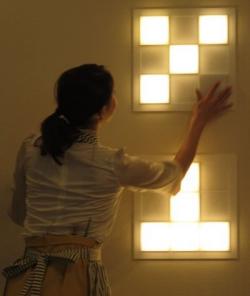
The second panels are transparent and Toshiba says that they implemented a unique device structure that emits most of the light (over 95%) in only one direction - which saves light and power in some installations.
Toshiba shows a prototype OLED watch
Toshiba has unveiled a (rather large and bulky) Bluetooth watch prototype called the Computer Graphics watch. It sports a 320x100 OLED panel (probably a PMOLED), an ARM processor and a Electrocardiogram (ECG) sensor. The idea is that this watch can sync to your smartphone for notifications and all sorts of applications (such as a heart-rate monitor which of course uses the ECG).
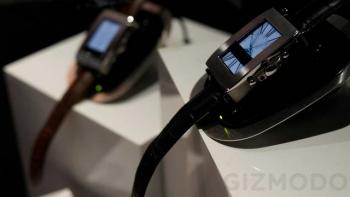
This isn't a new idea. Sony is offering a similar Android accessory called the SmartWatch (which also uses a PMOLED display, by the way, although at 1.3"). Sony's SmartWatch costs $109. The first-gen Sony LiveView, by the way, is now down to only $22.
LG Display - we're in talks with Japanese TV makers to supply OLED panels
LG Display's CEO, Han Sang-beom, says that the company is in talks with Japanese TV makers for the supply of OLED TV panels. Han says that the Japanese companies are "very much interested in OLED panels".
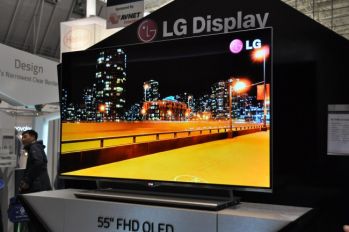
Last week LG Display finally launched their first OLED TV, the 55" 55EM9700 - which costs around $10,000 in Korea and $12,000 in the US (will start shipping in March). LG capacity is still very low so it seems strange that they will be able to supply other companies besides LGE. Still it seems that even though LG plans to invest heavily in OLED TV production in 2013, a commitment from another maker for OLED panels will make LGD more confident in its OLED investment.
Toshiba to commercialize OLED lighting panels by early 2015
Toshiba held an R&D open house at its Tokyo Headquarters, showing up a few future projects. One of them is OLED lighting. Toshiba unveiled prototype panels that are very efficient at 91 lm/W (@1000 cd/m2). Toshiba hopes to start selling their OLED lighting panels by early 2015.
Back in 2010 it was reported that Toshiba (or TMDisplay, really) is scrapping plans for OLED displays, but will continue to do R&D in OLED lighting manufacturing equipment. In May 2011 Toshiba produced 100 OLED based portable lamps and distributed them to quake-hit areas in Japan. Toshiba produced those panels, and Universal Display donated OLED materials and technology for those lamps. It's highly likely that Toshiba is using phosphorescent materials in their new lamp (getting to 91 lm/W with a fluorescent-only design is highly unlikely).
Japan Display to start producing OLED panels by March 2013
 Japan Display (the new small/medium display maker that merged Sony, Hitachi and Toshiba's businesses) announced that it plans to start mass producing OLED displays for smartphones. First panel samples are expected by March 2013. In order to have an edge over Samsung, JD aims to achieve over 300 ppi and develop panels that are more efficient than Samsung's OLEDs. Analysts suggest that JD will try to secure Apple as a customer for their OLED panels.
Japan Display (the new small/medium display maker that merged Sony, Hitachi and Toshiba's businesses) announced that it plans to start mass producing OLED displays for smartphones. First panel samples are expected by March 2013. In order to have an edge over Samsung, JD aims to achieve over 300 ppi and develop panels that are more efficient than Samsung's OLEDs. Analysts suggest that JD will try to secure Apple as a customer for their OLED panels.
Back in November there were reports that JD plans to accelerate OLED mass production with a $1.3 billion investment in OLED R&D (which probably includes pilot production plants), and later on invest a further $1.4 billion towards mass production. It was suggested that JD may convert their Mobara LCD plant (bought from Panasonic) to LTPS and later to AMOLED production.
Pagination
- Page 1
- Next page

